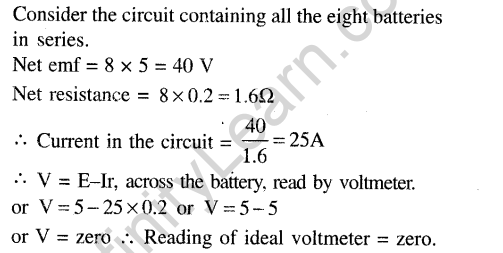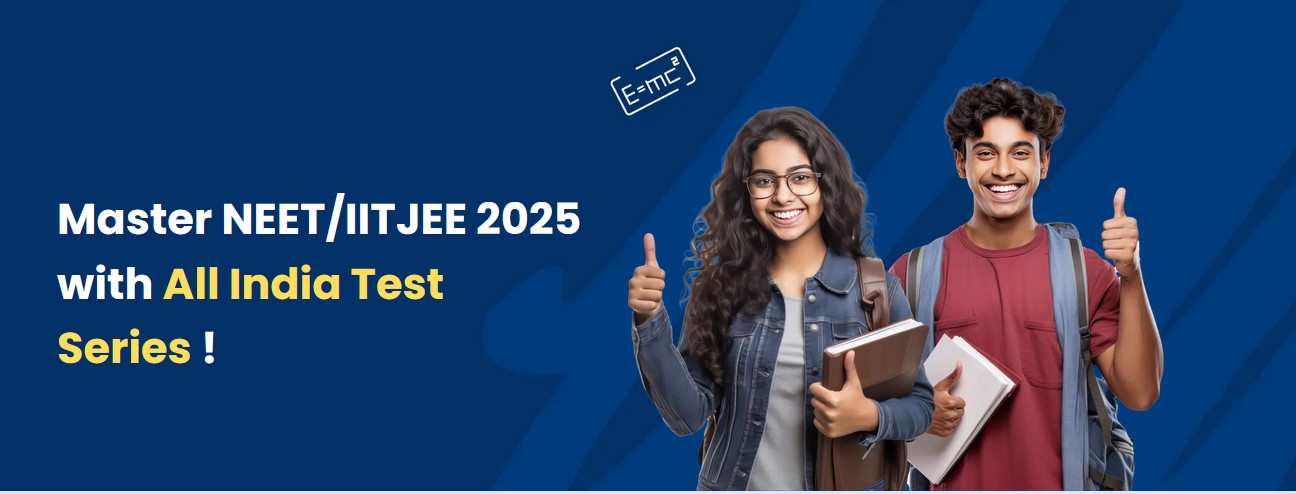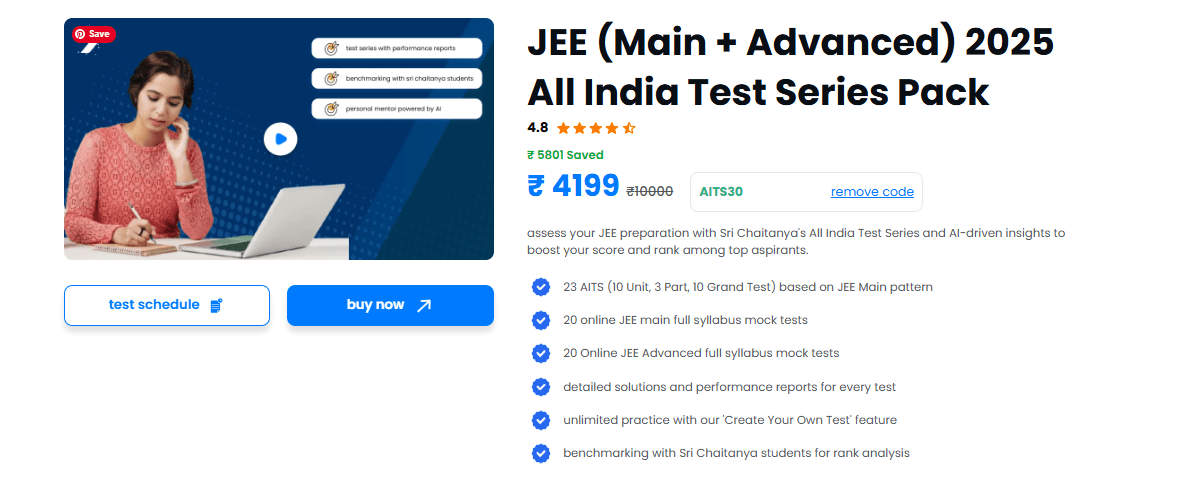Table of Contents
JEE Main Physics Current Electricity Previous Year Questions with Solutions
For JEE Main other Engineering Entrance Exam Preparation, JEE Main Physics Current Electricity Previous Year Questions with Solutions is given below.
Multiple Choice with ONE correct answer
1.A constant voltage is applied between the two ends of a uniform metallic wire. Some heat is developed in it.The heat developed is doubled if [1980]
a)both the length and the radius of the wire are halved.
b)both the length and the radius of the wire are doubled
c)the radius of the wire is doubled.
d)the length of the wire is doubled.
Ans.
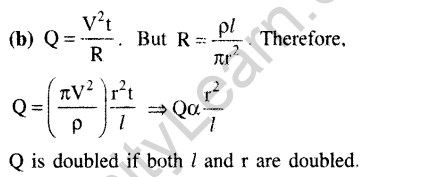
2.The temperature coefficient of resistance of a wire is 0.00125 per°C- At 300 K, its resistance is 1 ohm. This resistance of the wire will be 2 ohm at [1980]
a)1154 K b) 1100 K c) 1400 K d) 1127 K
Ans.

3.In the circuit shown in fig the heat produced in the 5 ohm resistor due to the current flowing through it is 10 calorie per second. The heat generated in the 4 ohm resistor is [1981-2 marks]

a)1 calorie/sec b) 2 calorie/sec
c) 3 calorie/sec d) 4 calorie/sec
Ans.
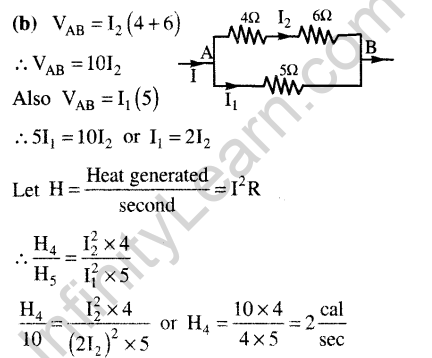
4.The current i in the circuit (see fig) is [1983-1 mark]
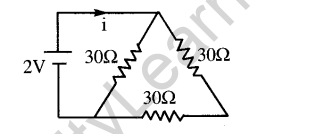
a)(1/45) ampere b) (1/15) ampere
c) (1/10) ampere d) (1/5) ampere
Ans.

5.A piece of copper and another of germanium are cooled from room temperature to 80 K. The resistance of [1988-1 mark]
a)each of them increases
b)each of them decreases
c)copper increases and germanium decreases
d)copper decreases and germanium increases.
Ans.(d) Copper is a metal. Its resistance decreases when temperature falls.Germanium is a semiconductor. Its resistance increases when temperature falls.
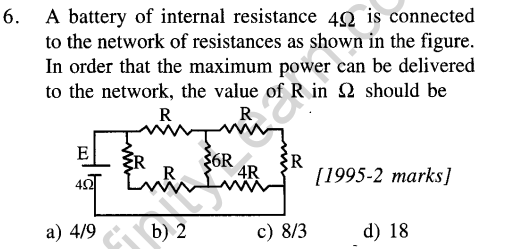
Ans.



Join Our Online Courses for JEE: JEE Class 11 Online Course | JEE Class 12 Online Course | JEE Dropper Online Course
7.A steady current flows in a metallic conductor of nonuniform cross-section. The quantity / quantities constant along the length of the conductor is / are: [JEE’97,lmark]
a)current, electric field and drift speed
b)drift speed only
c)current and drift speed
d)current only
Ans.
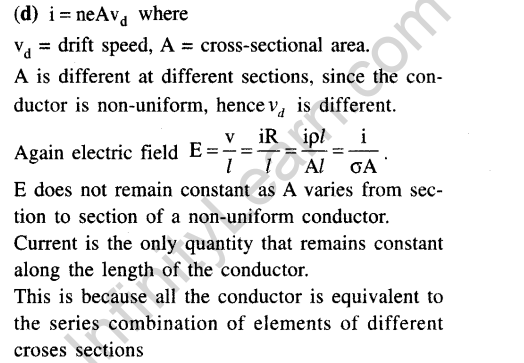
8.In the circuit shown, P1 R, the reading of the galvanometer is same with switch S open or closed.[JEE’99, 2]
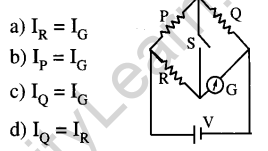
Ans.(a) This is Kelvin’s method of determining resistance of galvanometer by Wheatstone bridge circuit. Deflection in galvanometer G is same with switch S open or closed. It means that there is no current through S. This happens when the potentials at the two ends of S are same. This is the condition of balanced Wheatstone bridge.IP = IQ and IR = IG
9.In the given circuit, with steady current, the potential drop across the capacitor must be [2001-2 marks]

a)V b)V/2 c)V/3 d)2V/3
Ans.
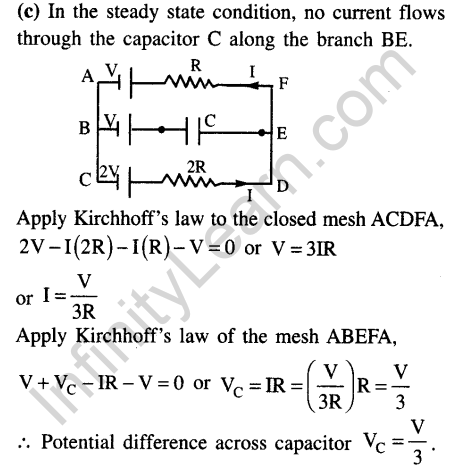
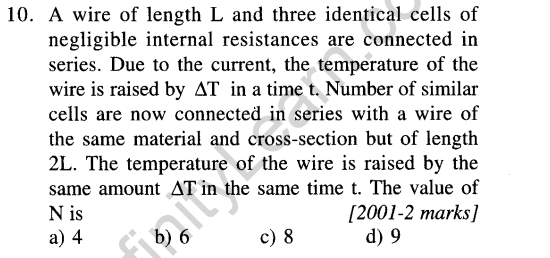
Ans.

11.In the given circuit, it is observed that the current I is independent of the value of the resistance R6. Then the resistance values must satisfy
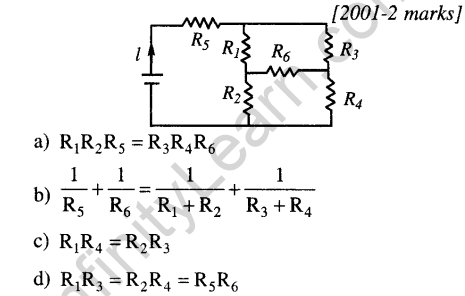
Ans.(c) Since current I is independent of the value of resistance R6, it is clear that R1 R2, R3 and R4 are the resistances of the arms of a balanced Wheatstone bridge. R1 R4 = R2R3
12.The effective resistance between points P and Q of the electrical circuit shown in the figure is [2002-2 marks]
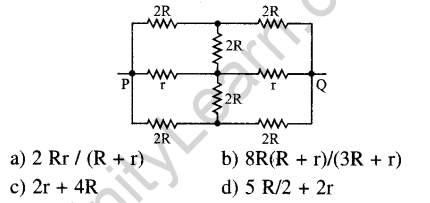
Ans.Consider upper segment above PQ.It is a balanced Wheatstone bridge. The central resistance 2R becomes ineffective.Similarly in the lower segment, the central resistance 2R becomes ineffective.

13.A 100 W bulb B1 and two 60 W bulbs B2 and B3, are connected to a 250 V source, as shown in the figure. Now W1, W2 and W3 are the output powers of the bulbs B1, B2 and B3 respectively. Then [JEE 2002 (Scr), 2]
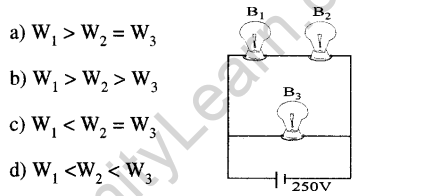
Ans.

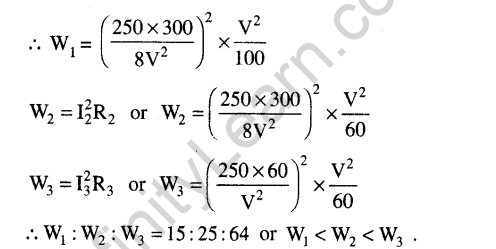
14.Express which of the following setups can be used to verify Ohm’s law? [2003-2m]
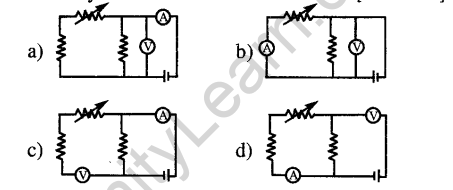
Ans.(a) Ammeter is connected in series with the resistance- net and voltmeter is connected in parallel with the resistance-net for verification of Ohm’s law. Setup (a) can be used for the purpose.
15.In the shown arrangement of the experiment of the meter bridge if AC corresponding to null deflection of galvanometer is x, what would be its value if the radius of the wire AB is doubled?[2003]
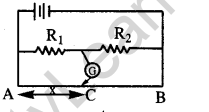
a) x b)x/4 c)4x d)2x
Ans.(a) For null deflection of galvanometer in a metre- bridge experiment,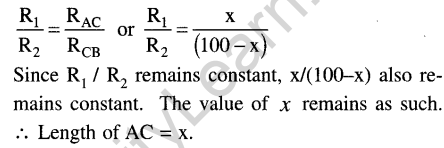

JEE Foundation Class for 10
JEE Foundation Class for 10 enhances critical thinking and problem-solving skills through engaging activities and advanced learning techniques, ensuring academic excellence.
16.Three resistances of equal value are arranged in the different combinations as shown below. Arrange them in increasing order of power dissipation. [2003-2 marks]

Ans.
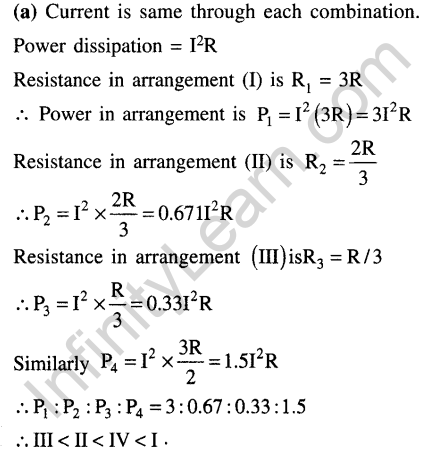
17.Shown in figure is a post office box. In order to calculate the value of external resistance, it should be connected between
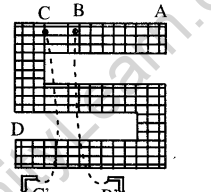
a)B’ and C’
b)A and D
c)C and D
d)B and D
Ans.(b) Post office box is Wheatstone bridge modified for measurement of an unknown resistance.AB, BC and CD are the three arms. The unknown resistance is connected between A and D.
18.Six identical resistors are connected as shown in the figure. The equivalent resistance will be [2004-2 marks]
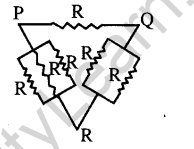
a)maximum between P and R
b)maximum between Q and R
c)maximum between P and Q
d)all are equal.
Ans.
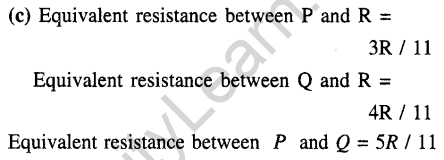

Ans.(a) Resistance of 2 0hms does not belong to any circuit where in a source of emf is connected. Hence no current flows through it.
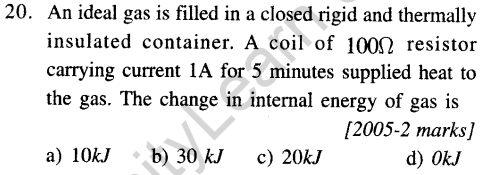
Ans.

21.If a steady current I is flowing through a cylindrical element ABC. Choose the correct relationship.[2006-3 marks]
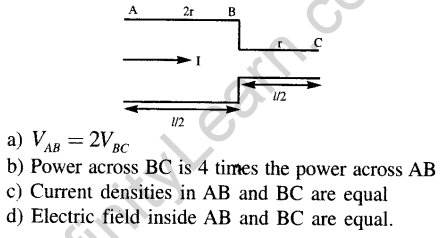
Ans.
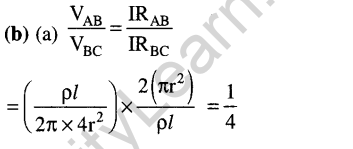
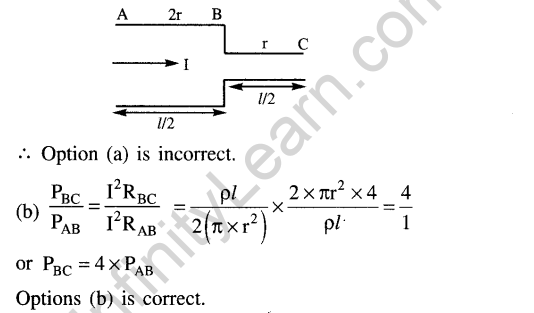
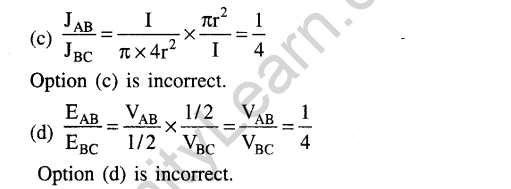
22.A circuit is connected as shown in the figure with the switch S open. When the switch is closed, the total amount of charge that flows from Y to X is [2007-3 marks]
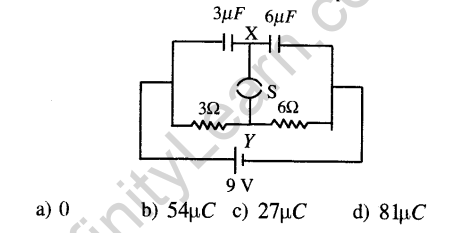
Ans.

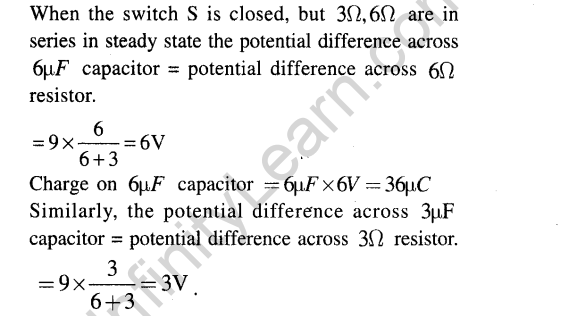

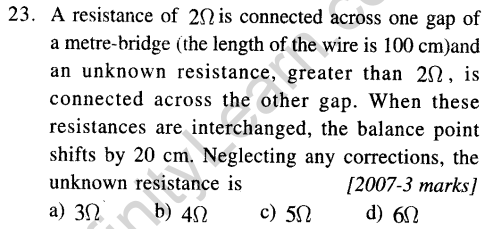
Ans.
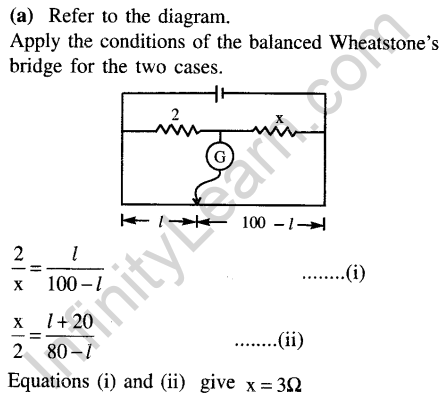

JEE Foundation Class for 9
JEE Foundation Class for 9 enhances critical thinking and problem-solving skills through engaging activities and advanced learning techniques, ensuring academic excellence.
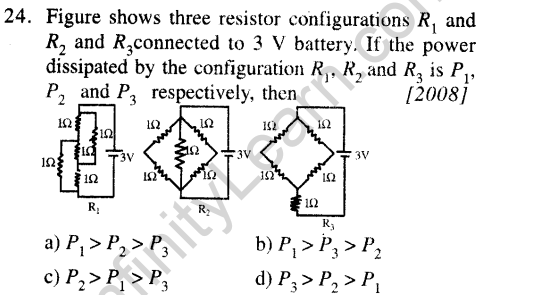
Ans.
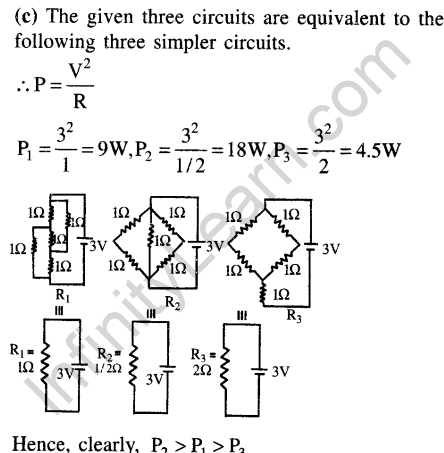
25.To verify Ohm’s law, a student is provided with a test resistor RT, a high resistance R1 a small resistance R2, two identical galvanometers G1 and G2, and a variable voltage source V. The correct circuit to carry out the experiment is
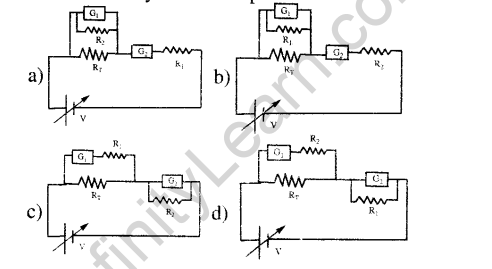
Ans..(c) Theoretical
26.Incandescent bulbs are designed by keeping in mind that the resistance of their filament increases with the increase in temperature. If at room temperature, 100 W, 60 W and 40 W bulbs have filament resistance R100, R60 and R40, respectively, the rlation between these resistance is.

Ans.

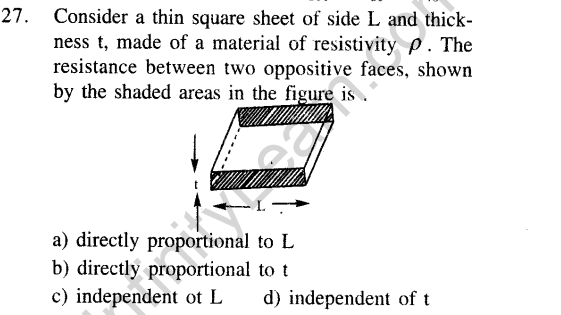
Ans.

28.A meter bridge is set-up as shown, to determine an unknown resistance ‘X’ using a standard 10 ohm resistor. The galvanometer shows null point when tapping – key is at 52 cm mark.The end-corrections are 1 cm and 2cm respectively for the ends A and B. The determined value of‘X’is (2011)
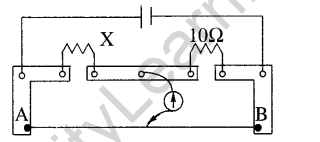
a)10.2 ohm b) 10.6 ohm
c) 10.8 ohm d) 11.1 ohm
Ans.
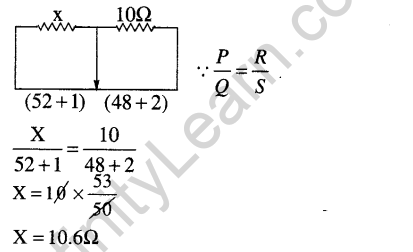
Multiple Choice with ONE or More Than ONE correct answers
29.Capacitor C1 Of capacitance 1 micro-farad and capacitor C2 of capacitance 2 microfarad are separately charged fully by a common battery. The two capacitors are then separately allowed to discharge through equal resistors at time t = 0[1989-2 marks]
a) The current in each of the two discharging circuits is zero at t=0
b)The currents in the two discharging circuits are equal but not zero.
c)The currents in the two discharging circuits at t=0 are unequal.
d)Capacitor C1 loses 50% of its initial charge sooner than C2 loses 50% of its initial charge.
Ans.
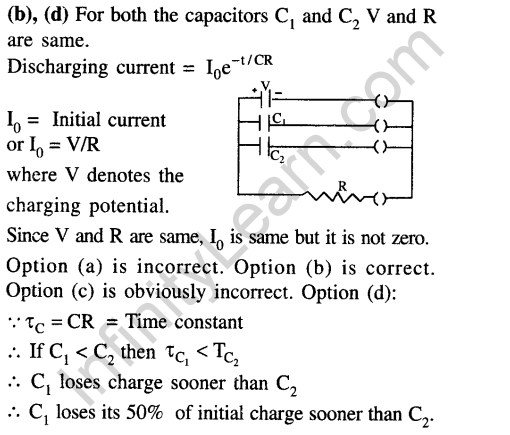
30.In the circuit shown in the figure, the current through :
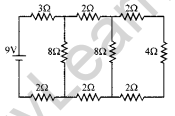
a) the 3W resistor is 0.50 A
b)the 3W resistor is 0.25 A
c)the 4 W resistor is 0.50 A
d) the 4W resistor is 0.25 A
Ans.

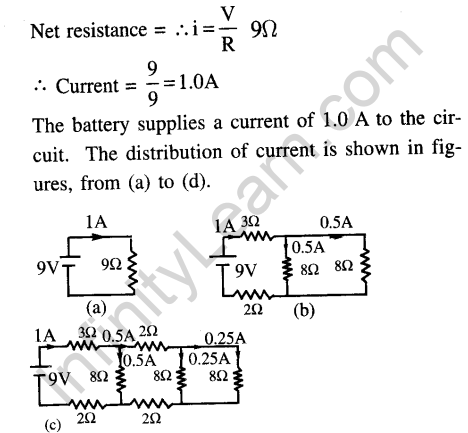
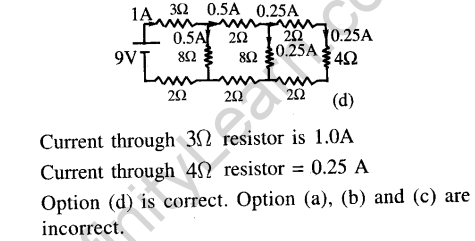
31.When a potential difference is applied across, the current passing through [1999-3 marks]
a) an insulator at 0 K is zero
b)a semiconductor at 0 K is zero
c)a metal at 0 K is finite
d)a p – n junction diode at 300 K is finite, if it is reverse biased
Ans.(a), (b), (d) (a) An insulator at 0 K does not permit any current to flow through it . Option (a) is correct.
(b)A semiconductor at 0 K becomes an insulator. Obviously the current flowing is zero.Option (b) is correct.
(c)A conductor becomes a superconductor at 0 K. The current will be infinite.Option (c) is incorrect.
(d)In reverse biasing at 300K, a small finite current flows, due to minority charge carriers, through a p-n junction diode.Option (d) is correct.
Hence options (a), (b) and (d) are correct.
32.For the circuit shown in the figure [2009]
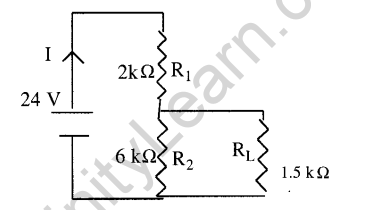
a)the current I through the batter is 7.5 mA
b)the potential difference across R1 ,is 18 V
c)ratio of powers dissipated in R1, and R2 is 3
d)if R1 and R2 are interchanged, magnitude of the power dissipated in RL will decrease by a factor of 9
Ans.
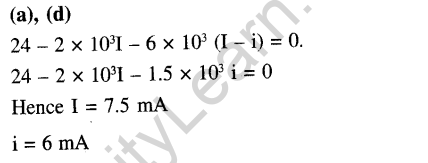

Assertion – Reasoning type
Instructions :The following question contains statement-I (assertion) and statement -2 (reason) of these statements, mark correct choice if
a)Statement-1 and 2 are true and statement-2 is a correct explanation for statement-1
b)Statement-1 and 2 are true and statement-2 is not a correct explanation for statement-1
c)Statement-1 is true, statement-2 is Base
d)Statement-1 is false, statement-2 is true.
33.Statement – 1 : The resistivity of a semiconductor increases with increase of temperature.
Statement – 2 : In a conducting solid, the rate of collisions between free electrons and ions increases with increase of temperature. [1993-2 marks]
Ans.(d)
34.Statement – 1 : In a Meter Bridge experiment, null point for an unknown resistance is measured. Now the unknown resistance is put inside an enclosure maintained at a higher temperature. The null point can be obtained at the same point as before by decreasing the value of the standard resistance. Statement – 2 : Resistance of a metal increases with increase in temperature. [2008]
Ans.
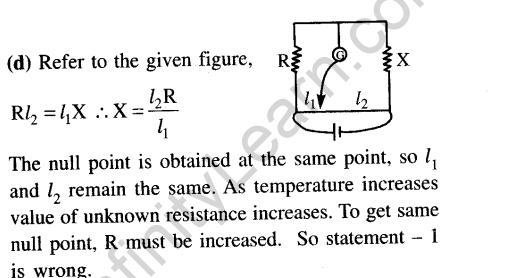
Comprehension based question
Electrical resistance of certain materials, know as superconductors, changes abruptly from a nonzero value to zero as their temperature is lowered below a critical temperature Tc(0). An interseting property of supercondeuctors is that their critical temperature becomes smaller than Tc(0)if they are placed in a magnetic field, i.e., the critical temperature TC(B) is a function of the magnetic field strength B. The dependence of TC(B) on B is shown in the figure.
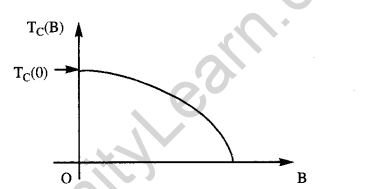
35.In the graphs below, the resistance R of a superconductor is shown as a function of its temperature T for two different magnetic fields B1 (solid line) and B2 (dashed line). If B2 is large than B1, which of the following graphs shows the correct variation of R with T in these fields ?
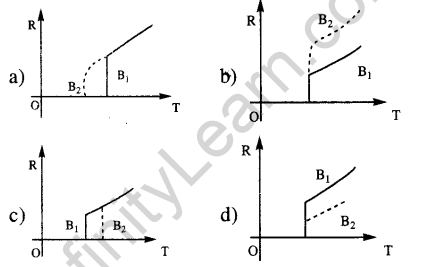
Ans.(a) Under magnetic field, the critical temperatures decreases as given in the data therefore the super conductors become conductors for higher magnetic field at low temperature.
36.A superconductor has Tc(0) = 100 K. When a magnetic field of 7.5 Tesla is applied, its Tc decreases to 75 K. For this material one can definitely say that when.
a)B = 5 Tesla, Tc (B) = 80 K
b)B = 5 Tesla, 75 K < Tc (B) < 100 K
c)B = 10 Tesla, 75 K < Tc (B) < 100 K
d)B = 10 Tesla, Tc (B) = 70 K
Ans.(b) When ‘B’ is increased, TC(B) decreased where solid becomes super conductor. If B = 7.5 tesla given that ‘Tc(0) decreased from 100 K to 75 K. If ‘B’ is less than 7.5 then TC(B) stightly increases, it should be in between 75 K and 100 K so if B = 5 Tesla, 75 K < TC(B) < 100 K
Matching Type
37.Column – I gives certain situations in which a straight metallic wire of resistance R is used and Column II gives some resulting effects. [2007]

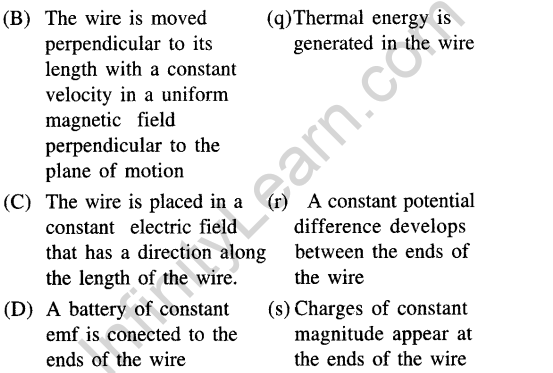
Ans.A) Energy stored in the capacitor is converted into heat /thermal energy when connected to a wire.B)Due to motional emf a constant potential difference and charges of constant magnitude appear at the ends of the wire.
C)Due to induction a constant charge and there by a constant potential difference appears at the ends of the conductor.
D)A source of constant emf is conneced to a conducting wire then (i) a constant potential difference (ii) a constant current and (iii) Heat is generated in the wire.
Subjective / Numerical integer type
38.A copper wire is stretched to make it 0.1% longer. What is the percentage change in its resistance?[1978]
Ans.
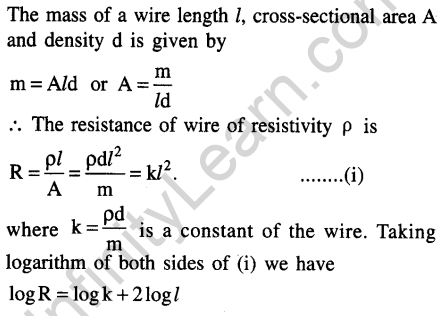
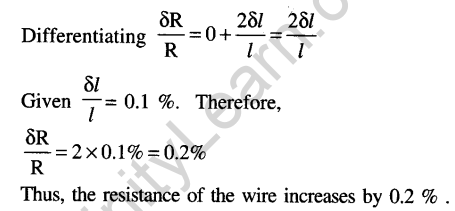
39.If each of the resistances in the network shown in the figure is R, what is the resistance between the terminals A and B? [1978]
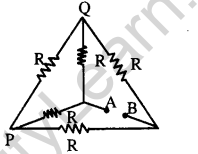
Ans.The circuit diagram can be redrawn as shown in the figure. This is equivalent to a balanced Wheatstone bridge. Since points P and Q are at the same potential, no current flows in the resistance R connecting them. Resistance X between A and B is, therefore, given by
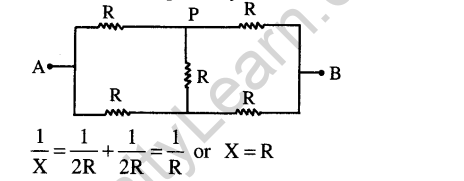
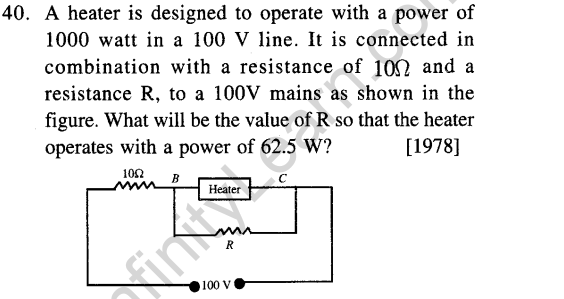
Ans.

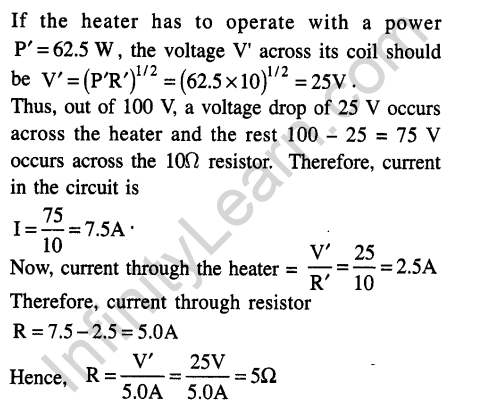
41.A 25 watt and a 100 watt bulb are joined in series and connected to the mains. Which bulb will glow brighter? [1979]
Ans.
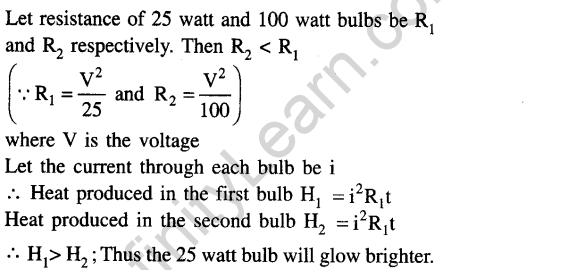
42.A copper wire having cross-sectional area of 0.5 mm2 and a length of 0.1 metre is initially at 25°C and is thermally insulated from the surrounding. If a current of 10 ampere is set up in this wire, i) find the time in which the wire will start melting. The change of resistance with the temperature of the wire may be neglected, ii) What will this time be, if the length of the wire is doubled?

Ans.
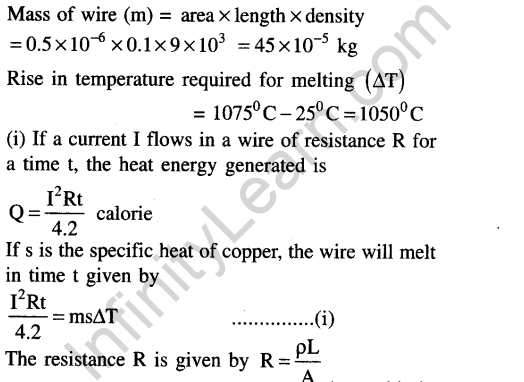
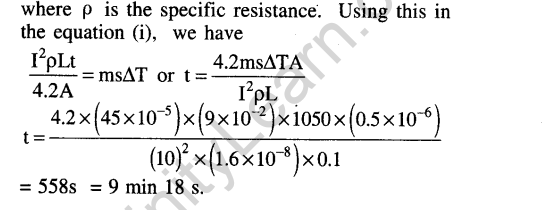
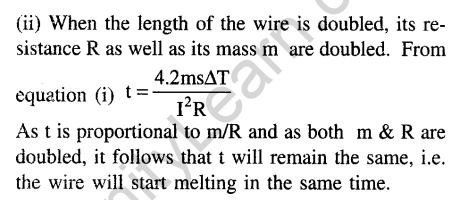
43.Find the potential difference between the points A and B and between the points B and C in the steady state. [1979]
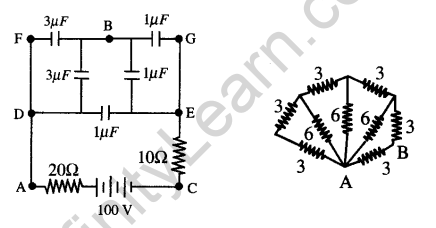
Ans.
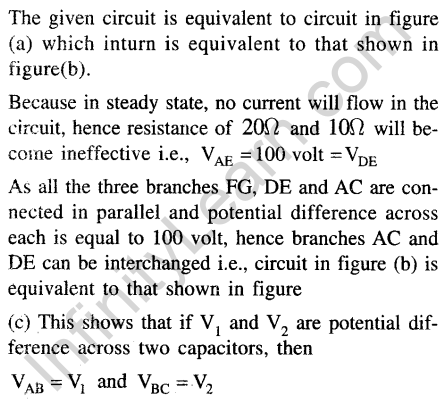
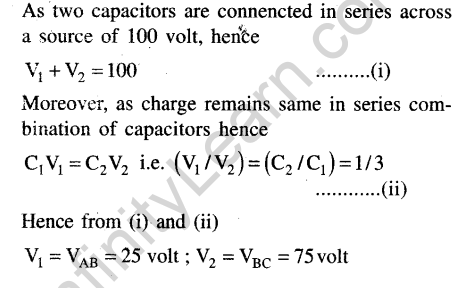
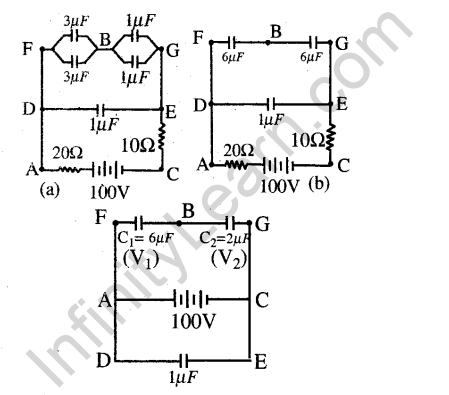
44.All resistance in the diagram below are in ohm. Find the effective resistance between the points A and B.[1979]
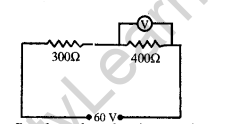
Ans.
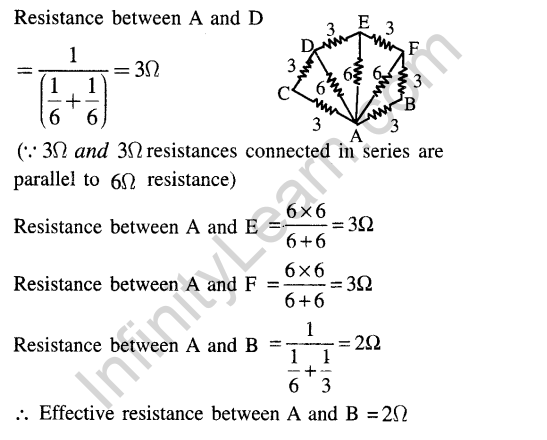
45.In the circuit shown in figure, a voltmeter reads 30 volts when it is connected across 400 ohm resistance. Calculate what the same voltmeter will read when it is connected across the 300 ohm resistance. [1980]
Ans.
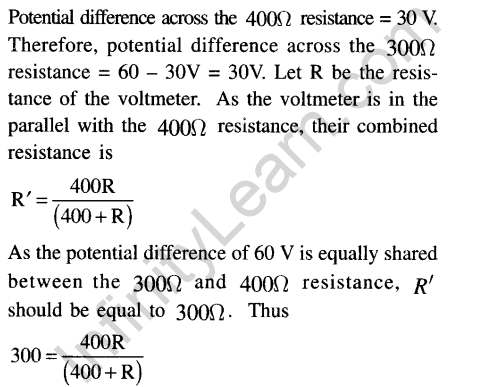
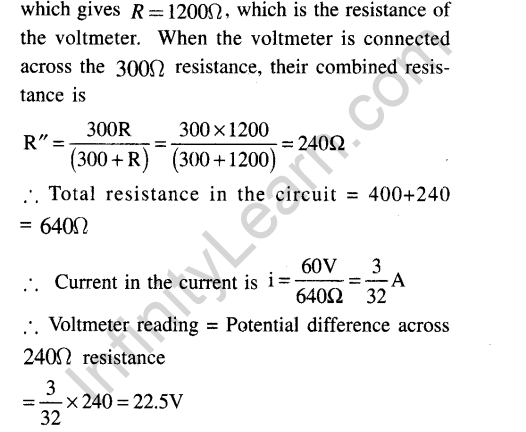
46.A battery of emf 2 volt and internal resistance 0.1 ohm is being charged with a current of 5 ampere. In what direction will the current flow inside the battery? What is the potential difference between the two terminal of the battery? [1980]
Ans.In order to charge a battery, its positive terminal is to be connected to the positive terminal of the charger (figure). Hence, inside the battery, the direction of flow of current is from the positive terminal to the neagative terminal.
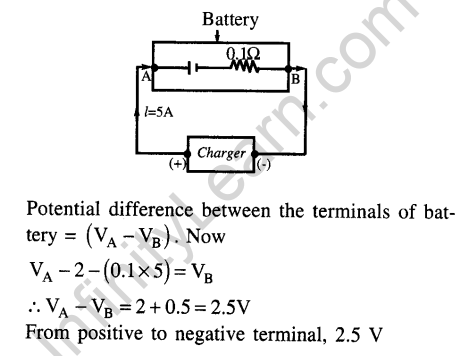
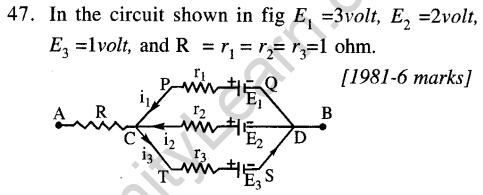
i)Find the potential difference between the points A and B and the currents through each branch.
ii)If r2 is short circuited and the point A is connected to point B, find the currents through E1, E2, E3 and the resistor
Ans.
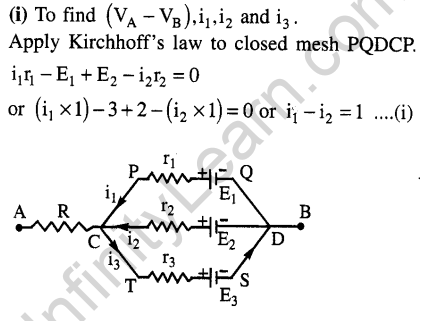
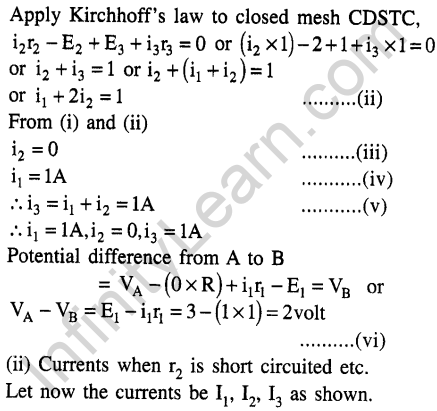
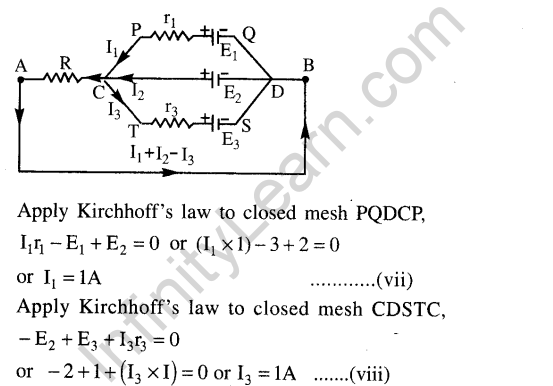

48.Calculate the steady state current in the 2 ohm resistor shown in the circuit in the figure. The internal resistance of the battery is negligible and the capcitance of the condenser C is 0.2 microfarad.[1982-5 marks]
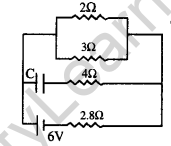
Ans.

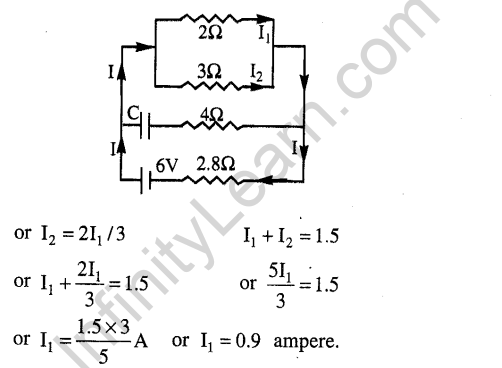
49.Two resistors, 400 ohm and 800 ohm are connected in series with a 6 volt battery. It is desired to measure the current in the circuit. An ammeter of 10 ohm resistance is used for this purpose. What will be the reading in the ammeter? Similarly, if a voltmeter of 10,000 ohm resistance is used to measure the potential difference across the 400 ohm resistor, what will be the reading in the voltmeter? [1982-5 marks]
Ans.
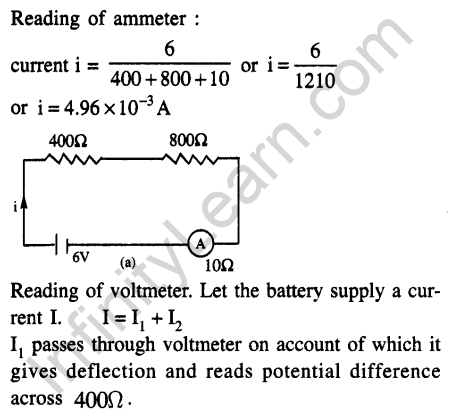
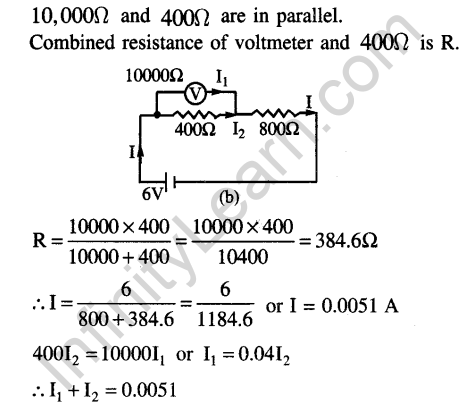
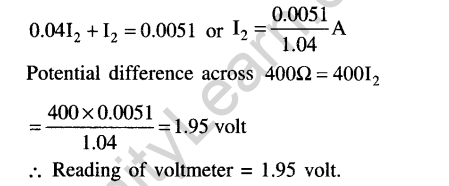
50.A steady current passes through a cylindrical conductor. Is there an electric field inside the conductor? [1982-2 marks]
Ans.Yes. There is an electric field inside the conductor.In electrostatic condition, electric field inside a conductor is zero. But in this case a current flows through the cylinderical conductor. Hence there is an electric field inside the conductor.
51.In the circuit shown in the figure A E E,F,G,H are cells of emf 2, 1, 3 and 1 volt respectively, and their internal resistances are 2,1,3 and 1 ohm respectively.Calculate : [1984-6 marks]

i)the potential difference between B and D and
ii)the potential difference across the terminals of each of the cells G and H.
Ans.

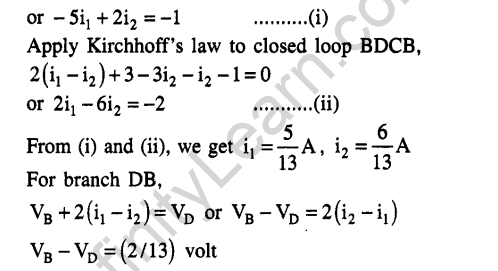
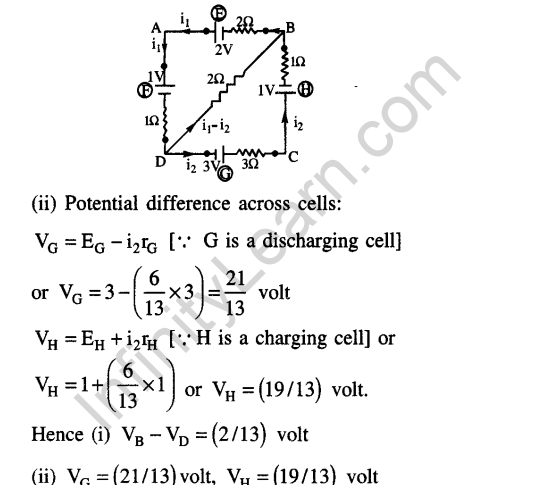
52.A part of circuit in a steady state along with the currents flowing in the branches, the values of resistances etc., is shown in the figure.Calculate the energy stored in the capacitor

Ans.
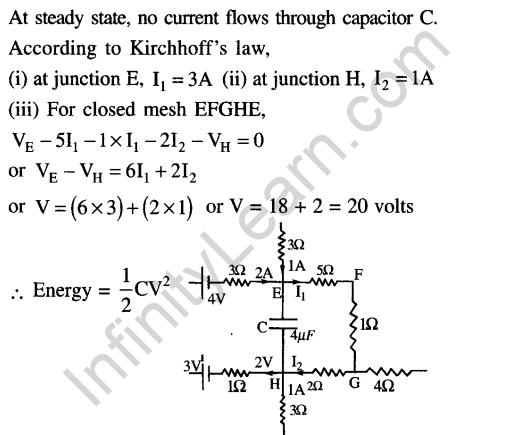
53.An infinite ladder network of resistances is constructed with 1 ohm and 2 ohm resistances, as shown in figure.The 6 volt battery between A and B has negligible internal resistance:

i)Show that the effective resistance between A and B is 2 ohm.
ii)What is the current that passes through the 2 ohm resistance nearest to the battery?[1987-7 marks]
Ans.In case of the infinite ladder of resistances, the effective resistance remains the same when one identical item is either added to it or removed from it.Let the effective resistance between A and B be R. The effective resistance between C and D will also be R.

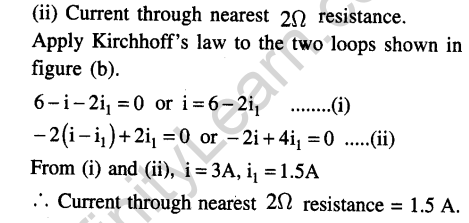
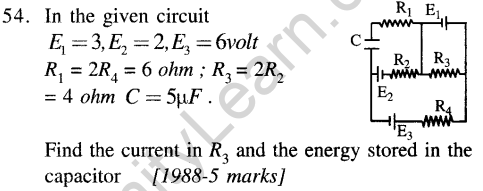
Ans.



55.An electrical circuit is shown in the figure. Calculate the potential difference across the resistor of 400 ohm, as will be measured by the voltmeter V of resistance 400 ohm, either by applying Kirchhoff’s rules or otherwise. [JEE’96, 5]
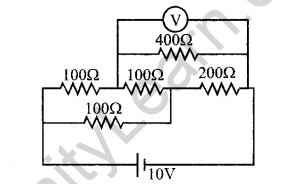
Ans.

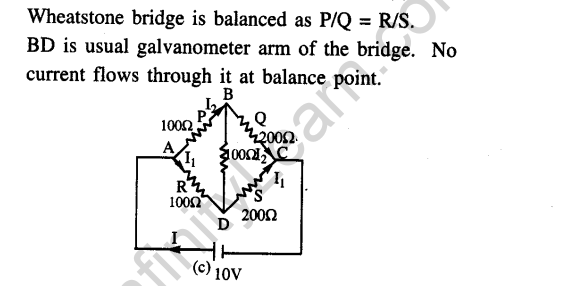

56.Find the emf (V) and internal resistance (r) of a single battery which is equivalent to a parallel combination of two batteries of emfs V1, and V2 and internal resistances r1 and r2 respectively, with polarities as shown in figure [1997-5 marks]
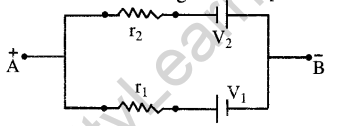
Ans.(i) EMF of battery is equal to potential difference across the terminals, when no current is drawn from battery (for external circuit) [Here, all the elements in the circuit are in series] Current in internal circuit = i
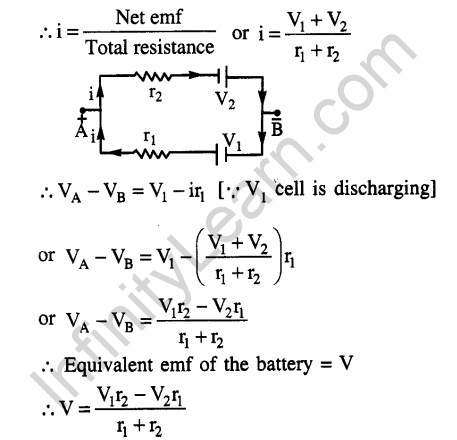


Ans.
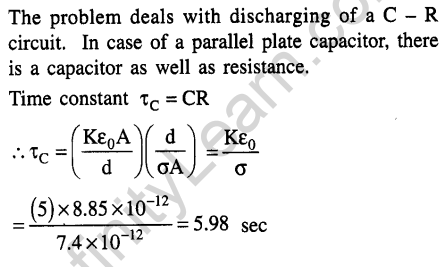
58.In the circuit shown in figure, the battery is an ideal one, with emf V. The capacitor is initially uncharged. The switch S is closed at time t=0.
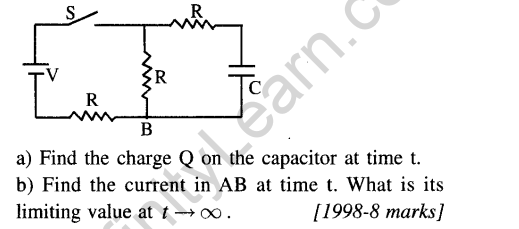
Ans.
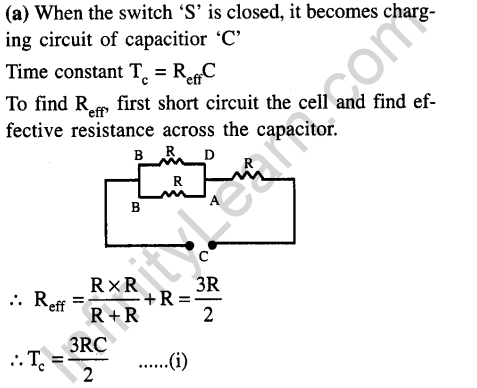
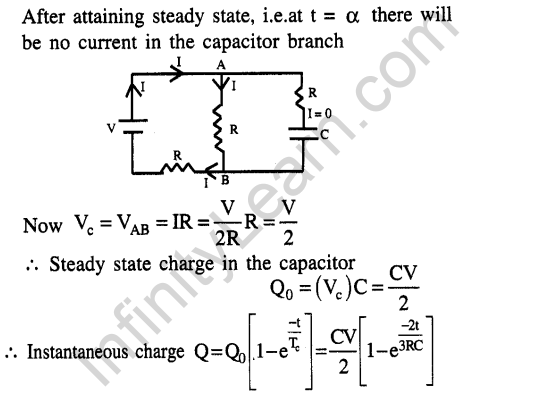

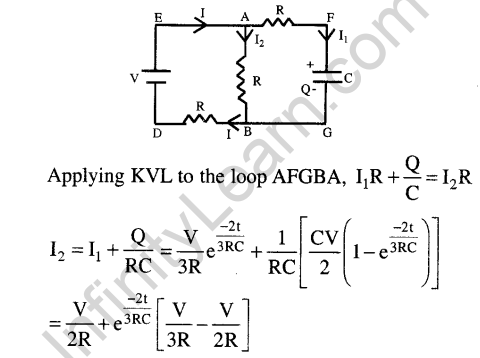

59.A thin uniform wire AB of length 1 m, an unknown resistance X and a resistance of 12 W are connected by thick conducting strips, as shown in the figure. A battery and a galvanometer (with a sliding jockey connected to it) are also available. Connections are to be made to measure the unknown resistance X using the principle of Wheatstone bridge. Answer the following questions.

a)Are there positive and negative terminals on the galvanometer?
b)Copy the figure in your answer book and show the battery and the galvanometer (with jockey) connected at appropriate points.
c)After appropriate connections are made, it is found that no deflection takes place in the galvanometer when the sliding jockey touches the wire at a distance of 60 cm from A. Obtain the value of the resistance X. [2002-1 + 2 + 2 marks]
Ans.(a) There are no positive and negative terminals on the galvanometer. The pointer swings depending on current direction on both sides of central zero. For no current, the pointer stands at zero, (b) Jockey is a sliding contact on a resistance wire. AB is, infact, the resistance wire of the metre bridge experiment, based on the principle of Wheatstone bridge. Galvanometer and battery are shown in the figure
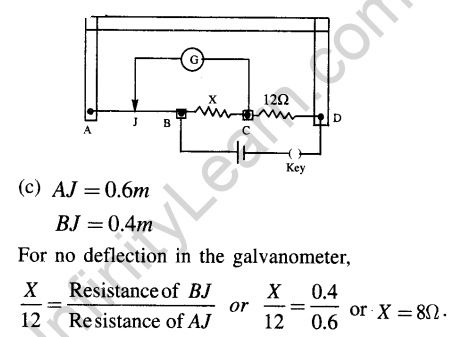
60.How a battery is to be connected so that the shown rheostat will behave like a potential divider? Also indicate the points about which output can be taken. [2003-2 marks]

Ans.
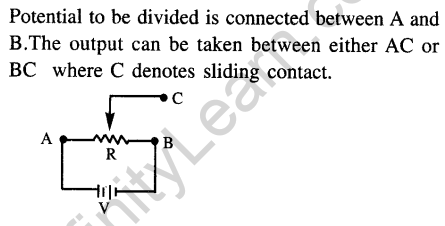

Ans.

62.The circuit shown in the figure is used to measure the value of an unknown resistance X bycomparing it with a known resistance R with three different known resistances. R = R1 , R = R2 and R = R3 . The corresponding null points are obtained at A,B and C. Find which of the above will give the most accurate reading and why? [2005-2 marks]
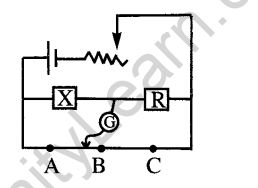
Ans.Wheatstone bridge is most accurate when all the four resistances of the four arms are of the same order of magnitude. Null point at B is almost at the center of resistance wire. The resistances of the wire to the left (P) and to the right (Q) of B are almost equal. Obviously as X/R = P/Q, the magnitudes of X, R, P and Q are almost or same order. Hence B position of null-point gives most accurate reading.

Ans.
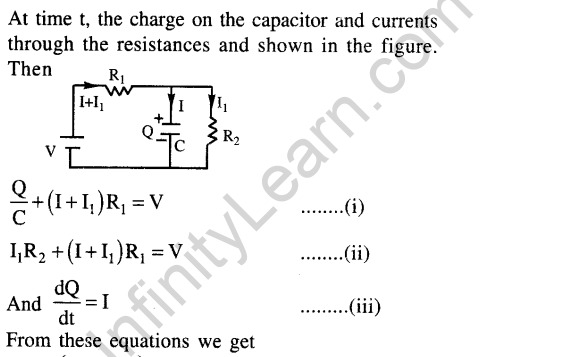
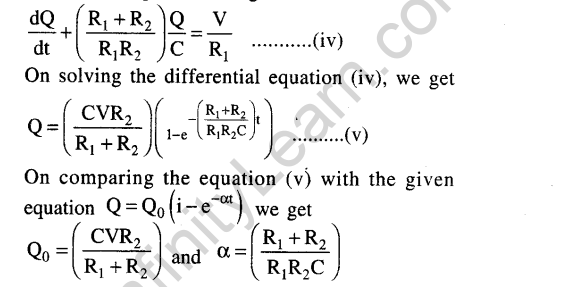
64.At time t = 0, a battery of 10 V is connected across points A and B in the given circuit. If the capacitors have no charge initially, at what time (in seconds) does the voltage across them become 4 V ?
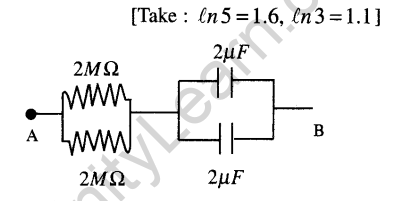
Ans.
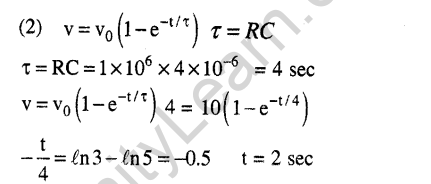
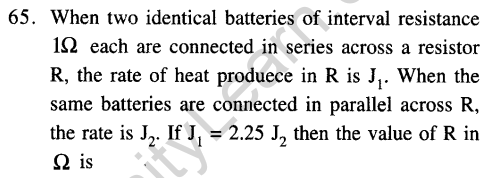
Ans.
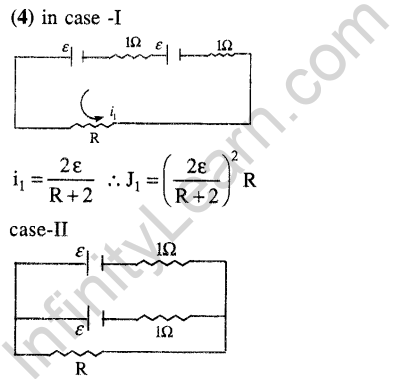

66.Two batteries of different emfs and different internal resistance are connected as shown. The voltage across AB in volts is
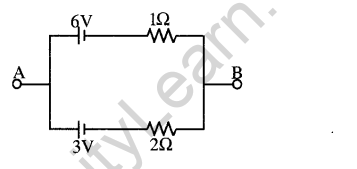
Ans.

True / False type
67.In an electrolytic solution the electric current is mainly due to the movement of free electrons.[1980]
Ans.False. When a current passes through a solution of some electrolyte, the substance decomposes into positively and negatively charged particles, called ions. When an electric field is set up in the solution by dipping the electrodes, the two kinds of ions to drift in opposite direction. Their movement constitutes electric current in the solution.
68.Electrons in a conductor have no motion in the absence of a potential difference across it.[1982-2 marks]
Ans.False.The electrons in a conductor move with thermal velocities freely. Their motion is random in the absence of potential difference. The statement is false.
69.The current-voltage graphs for a given metallic wire at two different temperatures Tl and T2 are shown in the figure. The temperature T2 is greater than T1.[1985-3 marks]
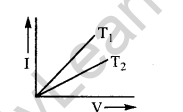
Ans.True.For a metallic wire, the resistance increases with increase of temperature. Evidently the current in a wire decreases a higher temperature, for a given potential difference V. In the given I-V graph,current is less at T2.
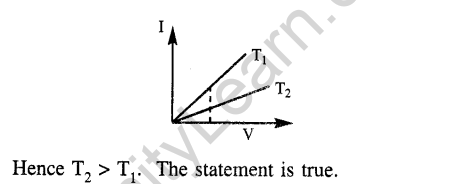
Fill in the blanks type
70.An electric bulb rated for 500 watt at 100 volt is used in a circuit having a 200 volt supply. The resistance R that must be put in series with the bulb, so that the bulb delivers 500 watt is…………..ohms [1987-2 marks]
Ans.
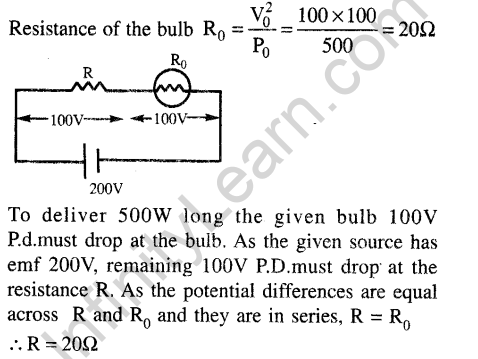
71.The equivalent resistance between points A and B of the circuit given is…………… [1997-2 marks]

Ans.
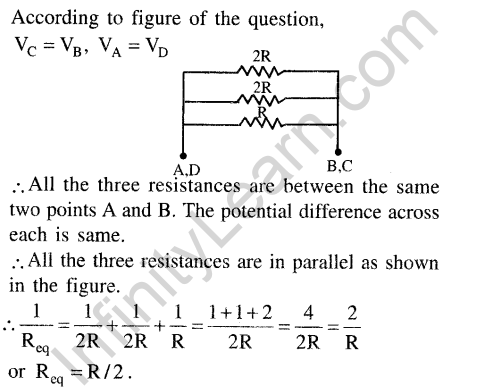
72.In the circuit shown each battery is 5V and has an internal resistance of 0.2 ohm. The reading in the ideal voltmeter V is………….V.

Ans.
